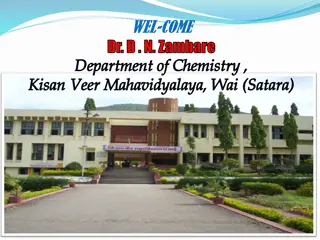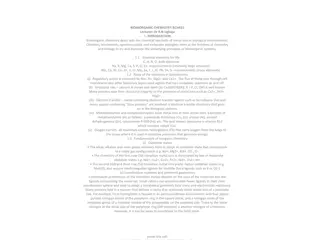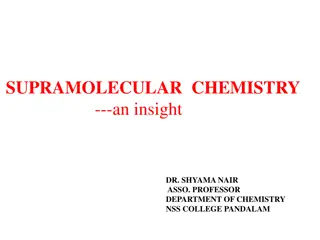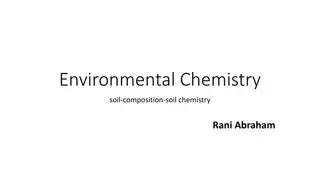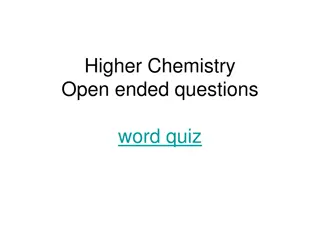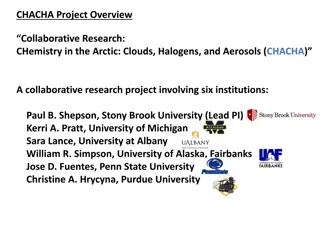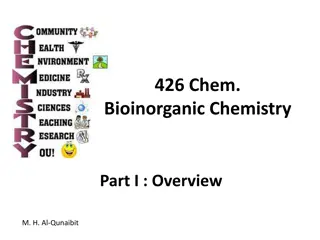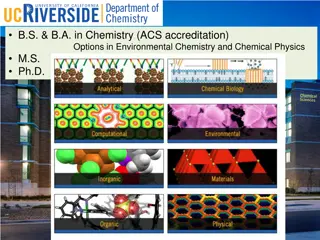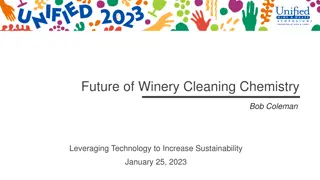CHEMISTRY INTERDISCIPLINARY PROJECT
Endothermic and exothermic reactions involve heat energy absorption or release during chemical processes. Examples of substances exhibiting these behaviors include Ammonium chloride and Potassium nitrate as endothermic, and Sodium hydroxide as exothermic. Explore their properties, applications, and implications in various industries.
Download Presentation

Please find below an Image/Link to download the presentation.
The content on the website is provided AS IS for your information and personal use only. It may not be sold, licensed, or shared on other websites without obtaining consent from the author.If you encounter any issues during the download, it is possible that the publisher has removed the file from their server.
You are allowed to download the files provided on this website for personal or commercial use, subject to the condition that they are used lawfully. All files are the property of their respective owners.
The content on the website is provided AS IS for your information and personal use only. It may not be sold, licensed, or shared on other websites without obtaining consent from the author.
E N D
Presentation Transcript
CHEMISTRY INTERDISCIPLINARY PROJECT By: Rita Halteh, Fares Ghawi, and Rami Abu Eita. 7C
WHAT ARE ENDOTHERMIC AND EXOTHERMIC REACTIONS? Exothermic and endothermic changes refer to the heat energy released or absorbed during a chemical process. When substances dissolve in water, they can exhibit either exothermic or endothermic behavior. Let's explore some examples of substances and their dissolution properties.
ENDOTHERMIC DISSOLUTION 1- Ammonium chloride (NH4Cl): Dissolving ammonium chloride in water is an endothermic process, meaning it absorbs heat from the surroundings. This property is utilized in cold packs or instant cold compresses for therapeutic or first-aid purposes. -Chemical Properties: Ammonium chloride is a white crystalline salt composed of ammonium (NH4+) and chloride (Cl-) ions. It is soluble in water and has a mildly acidic taste. Uses: Some common applications of ammonium chloride include: -Fertilizer: It is used as a nitrogen source in fertilizers, particularly for crops requiring high levels of chloride, such as rice. -Laboratory Reagent: Ammonium chloride is utilized in laboratories as a reagent for pH adjustments, buffer preparations, and precipitation reactions. -Food and Beverage Industry: It is used as a food additive, mainly in baking powders and as a flavoring agent in licorice.
ENDOTHERMIC DISSOLUTION 2- Potassium nitrate (KNO3): The dissolution of potassium nitrate in water is endothermic. It is often used in homemade "hot ice" or "hot ice sculptures" demonstrations, where the dissolving process absorbs heat, resulting in a temperature drop and the formation of crystalline structures. -Chemical Properties: Potassium nitrate is a colorless or white crystalline solid that is highly soluble in water. It consists of potassium (K+), nitrate (NO3-) ions, and is an oxidizing agent. Uses: Potassium nitrate has a range of applications, including: -Fertilizer: It is a significant component of fertilizers due to its high nitrogen content and as a source of potassium for plants. -Food Preservation: Potassium nitrate is used as a food preservative, especially in cured meats, to inhibit bacterial growth and maintain color. -Pyrotechnics: It is a key ingredient in fireworks and explosives due to its oxidizing properties.
EXOTHERMIC DISSOLUTION 1- Sodium hydroxide (NaOH): Dissolving sodium hydroxide in water is an exothermic process, meaning it releases heat. This property is exploited in various applications such as drain cleaners, where the heat generated aids in dissolving organic materials and clearing clogs. -Chemical Properties: Sodium hydroxide, also known as caustic soda, is a white, odorless solid that is highly soluble in water. It is a strong base and a corrosive substance. Uses: Sodium hydroxide finds extensive applications in various industries, including: -Soap and Detergent Production: It is used in the manufacturing of soaps and detergents by saponifying fats and oils. -Water Treatment: Sodium hydroxide is employed in water treatment processes to adjust pH levels and remove heavy metals. -Paper and Pulp Industry: It is used in the production of paper and pulp to break down lignin and facilitate the separation of fibers.
EXOTHERMIC DISSOLUTION 2- Calcium chloride (CaCl2): The dissolution of calcium chloride in water is highly exothermic. It is commonly used as a de-icing agent for roads and sidewalks, as the heat produced during dissolution helps melt ice and lower the freezing point of water. -Chemical Properties: Calcium chloride is a white, crystalline solid that is highly soluble in water. It is hygroscopic, meaning it readily absorbs moisture from the atmosphere. Uses: Calcium chloride has numerous applications, including: -De-icing and Dust Control: It is widely used as a de-icing agent to melt ice and snow on roads and sidewalks. It is also used for dust control in construction and mining. -Food Industry: Calcium chloride is used as a firming agent, preservative, and a source of calcium in food processing. -Desiccant: It is employed as a desiccant to control humidity and absorb moisture in various industrial processes. *These examples demonstrate how certain substances, when dissolved in water, can exhibit either endothermic or exothermic behavior, resulting in temperature changes. The ability to harness and control these energy changes has practical applications in various fields.
CHEMICAL EQUATION : AMMONIUM CHLORIDE REACTION WITH WATER NH4Cl(s)+H2O(I) NH4OH(aq)+HCl(aq)
CHEMICAL EQUATION : POTASSIUM NITRATE REACTION WITH WATER KNO3(s)+H2O(l) KOH(l)+HNO3(l)
CHEMICAL EQUATION : SODIUM HYDROXIDE REACTION WITH WATER NaOH H 2 O OH-+ Na
CHEMICAL EQUATION : CALCIUM CHLORIDE REACTION WITH WATER CaCl 2 ( aq ) Ca 2 + ( aq ) + 2 Cl - (aq)
TABLE OF TEMPERATURE CHANGE Substance Temperature before Temperature after Temperature change T=Tf Ti = 10-25= -15 C Sodium hydroxide 25 C 10 C Exothermic Calcium Chloride 20 C 10 C 10-20= -10 C Exothermic Ammonium chloride 30 C 70 C 70-30= 40 C Endothermic Potassium nitrate 28 C 60 C 60-28= 32 C


